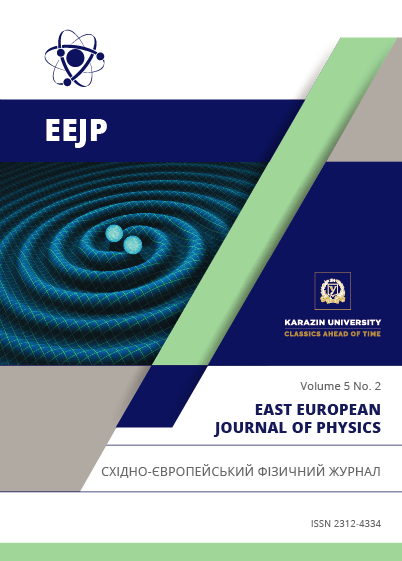Approach to Evaluate the Risk of Cancer for Different Number of Tumor Suppressor Genes in the Individual
Abstract
Significant progress in understanding the mechanisms of carcinogenesis is associated with the discovery of tumor suppressor genes (or antioncogenes). It is known that in the human population, the number of normally functioning suppressor genes varies in different individuals at birth. The aim of the study was to assess the probability of cancer development in an individual with a different initial number of undamaged normally functioning antioncogenes. On the basis of the probabilistic mathematical model of carcinogenesis, the most probable age of cancer development depending on the number of intact antioncogenes was assessed. As a result of the studies, the probability of cancer development depending on the age of the patient is estimated. The dependence of the probability of cancer development in an individual on the number of undamaged antioncogenes is also investigated. The analysis of the significance of the number of tumor suppressor genes, the damage of which may be the cause of initiation of cell malignancy, has been carried out.
Downloads
References
Kopnin B.P., Kopnin P.B., Khromova N.V., Agapova L.S. Many-faced p53: a variety of forms, functions, a tumor of suppressive and oncogenic activities // Klinicheskaja onkogematologija [Clinical oncohematology]. – 2008. – Vol. 5. – No.1. – P. 3-10. (in Russian)
Kopnin B.P. Targets of oncogenes and tumor suppressors: the key to understanding the basic mechanisms of carcinogenesis // Biokhimija [Biochemistry]. – 2000. – Vol.6. – Iss. 1. – P. 5-33. (in Russian)
Palijchuk O.V., Polischuk L.Z. Ovarian cancer: familial cancer syndrome and clinical significance of mutation testing in the BRCA1 and BRCA2 genes // Onkologija [Oncology]. – 2016. – Vol. 18. – No. 1. – P. 20-26. (in Russian)
Abelev G.I. Immunology of human tumors // Priroda [Nature]. - 2000. – No. 2. – P. 20-25. (in Russian)
Clark М., Beker М. Cancer stem cells // V mire nauki [In the world of science]. - 2006. – No. 10. - P. 29-35. (in Russian)
Rechkunova N.I., Lebedeva N.A., Lavrik O.I. Tyrosyl-DNA-phosphodiesterase 1 is a new participant in the repair of apurine / apyrrimidine sites in DNA // Bioorganicheskaja himija [Bioorganic chemistry]. – 2015. – Vol. 41. – No.
– P. 531. (in Russian)
Kipen V.N., Snytkov E.V., Melnov S.B. The role of XRCC1, XRCC3 and PALB2 genes in the genesis of breast cancer // Ekologicheskij vestnik [Ecological bulletin]. – 2015. – No. 1 (31). – P.57-63. (in Russian)
Knudson A.G. Antioncogenes and human cancer // Proc. Natl. Acad. Sci. USA. – 1993. – Vol. 90(23). – P. 10914-10921.
Young-Sam Keum. Regulation of Nrf2-Mediated Phase II Detoxification and Anti-oxidant Genes // Biomolecules and Therapeutics (Seoul). - 2012.- Vol. 20(2). - P. 144–151.
Li W., Kong A.N. Molecular mechanisms of Nrf2-mediated antioxidant response // Mol. Carcinog. – 2009. – Vol. 48. – P. 91-104.
Vogelstein B., Kinzler K. W. Cancer genes and the pathways they control // Nat. Med. – 2004. – Vol.10. - P. 789–799.
Sharpless N.E., Depinho R.A. The mighty mouse: genetically engineered mouse models in cancer drug development // Nat. Rev. Drug Discov. – 2006. – Vol. 5. – P.741–754.
Hanahan D., Weinberg R.A. The hallmarks of cancer // Cell. – 2000. – Vol. 100. – P.57-70.
Hanahan D. Weinberg R.A. Hallmarks of cancer: the next generation // Cell. – 2011. - Vol. 144. – P. 646–674.
Van Der Flier L, Clevers H. Stem cells, self-renewal, and differentiation in the intestinal epithelium // Annual Review of Physiology. – 2009. – Vol. 71. – P.241–260.
Rodriguez-Brenes I.A., Komarova N.L., Wodarz D. Cancer-associated mutations in healthy individuals: assessing the risk of carcinogenesis // Cancer Research. – 2014. – Vol. 74(6). – P.1661–1669.
Zheng Z.C., Wang Q.X., Zhang W., Zhang X.H., Huang D.P. A novel tumor suppressor gene NCOA5 is correlated with progression in papillary thyroid carcinoma // Onco Targets Ther. – 2018. - Vol. 11. - P. 307-311.
TSGene 2.0: an updated literature-based knowledgebase for tumor suppressor genes // Nucleic Acids Res. – 2016. – Vol. 44. – P. 1023-1031.
Gohlke BO, Nickel J, Otto R, Dunkel M, Preissner R. CancerResource-updated database of cancer-relevant proteins, mutations and interacting drugs // Nucleic Acids Res. – 2016. – Vol. 44. – P. 932-937.
Harvey Lodish, Arnold Berk, S Lawrence Zipursky, Paul Matsudaira, David Baltimore, James Darnell. Molecular Cell Biology. Ch.24. - New York: W. H. Freeman, 2000. – 726 p.
Knigavko V.G., Radzishevskaja E.B., Bondarenko M.A. Mathematical modeling of carcinogenesis // Biofizychnyj visnyk [Biophysical bulletin]. - 2010. – No. 25(2). – P. 93-100. (in Russian)
Citations
Luminescent Analysis of Blood Serum for Diagnostics of Pathological and Pre-Pathological States of Cancer Patients
Bondarenko Marina, Zaytseva Olga, Trusova Valeriya, Moiseenko Anton, Rukin Aleksey, Utytskykh Tetyana & Morozova Oksana (2021) Journal of Fluorescence
Crossref
Authors who publish with this journal agree to the following terms:
- Authors retain copyright and grant the journal right of first publication with the work simultaneously licensed under a Creative Commons Attribution License that allows others to share the work with an acknowledgment of the work's authorship and initial publication in this journal.
- Authors are able to enter into separate, additional contractual arrangements for the non-exclusive distribution of the journal's published version of the work (e.g., post it to an institutional repository or publish it in a book), with an acknowledgment of its initial publication in this journal.
- Authors are permitted and encouraged to post their work online (e.g., in institutional repositories or on their website) prior to and during the submission process, as it can lead to productive exchanges, as well as earlier and greater citation of published work (See The Effect of Open Access).








